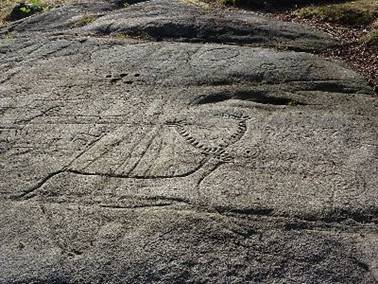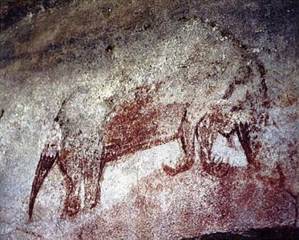|
Oahspe Study
Written Symbols and Images of Thor's Cycle
|
||||||
|
|
Archaeological scholars believe that such early art forms were an attempt by man to control his environment, especially in getting food. But while the exact reasons early humans painted are not fully understood, it is apparent that this activity was associated with the development of human expression through the use of symbols and representative images. Man was developing in abstract thinking and with that expansion of thought, also expanded his capacity to record events and more, in the first kinds of written language.
Petroglyph found in Galicia, Spain. (Image courtesy of Wikipedia)
The fact that this development occurred virtually simultaneously in far distant locations around the world when there was no known physical contact between the people of those places remains a mystery to archaeological scholars. They conclude that the races man respond to environment and need in similar fashion. If it were merely that, there would have been one culture with very little variation around the world throughout history. This however is not the case, and even within reasonable distance under the same environmental conditions, groups and communities can vary markedly from each other. Rather, what is proved by such simultaneous developments such as these rock carvings and paintings (and simultaneous agricultural developments) in various remote places around the world, is that the same direct intentional cause influenced those cultures at the same time in their own locations.
Oahspe can explain similarities across cultures which had no apparent interaction in various periods of history, including the above mentioned periods of Pleistocene Rock Art. Oahspe shows that the development of humans was, and continues, to progress under spiritual guidance. Oahspe's revelations have shown that through the united and concerted actions of the Gods and Lords and their hosts of angels of the various divisions of the earth and its heavens, humankind has been cultivated through the presence of angels to develop at appropriate levels of progress, even though no interaction or exchange of culture between mortals occurred. Thus the connection, being one of spirit, was often achieved without physical interaction between similar cultures located far distant from one another.
Oahspe also reveals that, since the flood (The Submersion of Pan around 25,000 years ago), it was from Arabin'ya (Egypt and the Middle East), westward that many of the descendents of the tribes of Ham (Khem is a cognate of this ancient name), survivors of the flood, were migrating. It should not then, be surprising that even in pre-historical artifacts, there is evidence of the waves of culture spreading North and West.
In particular, the apparent age (15,000 years) of the afore-mentioned rock carvings in Egypt, coincide with Oahspe's information regarding Thor's cycle on the earth (beginning circa 15,400 years ago). During this cycle of approx 3,000 years, humankind all over the world was given signs and symbols from which sprung modern man's written languages (Although not the first writing among men - the I'hin, the sacred little people, had writing since before the flood).
Oahspe's unique knowledge is validated in the corroborating details of these petroglyph discoveries because none of these sites were known to modern scholars at the time that Oahspe was written. Lascaux was discovered in 1940 and Altamira (the first one) had only been discovered in 1880, but was believed to be a fraud until around 1902 when other caves had been found which corroborated such unusual art-forms. Herein it is shown that Oahspe, from the spirit, has revealed what was yet to be found in physical evidence many years later.
Oahspe, The Lord's Fourth Bk, 17/1.2-6. || God said: Behold, with my sacred people I have established myself in written words. Now it has come to pass that all the races of man on earth shall be made to know me.
God commanded man to make stone and wooden images, and engravings also, of everything upon the earth. And so man made them; according to his own knowledge he made them.
God said: As every living creature has a name, so shall its image and its engraving have the same name. And so shall it be with all things on the earth, in its waters, and in the air above the earth; the image and the engravings shall have the same names as the real things themselves.
And God sent his angels down to man, to inspire him in the workmanship of images and engravings, and man thus accomplished the commandments of God.
And these were the first writings since the flood, other than those that were kept secret among the I'hins. ||
All Oahspe references are from the Oahspe Standard Edition 2007
● GO TO NEXT ARTICLE: Origins of Life on Earth
|
|




